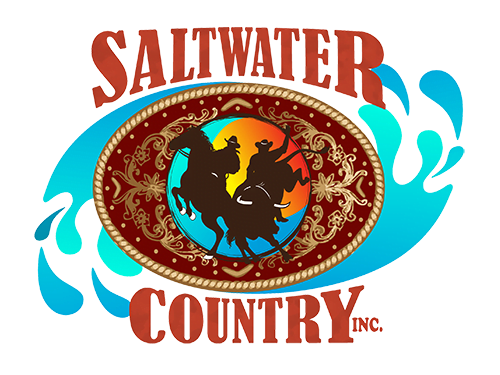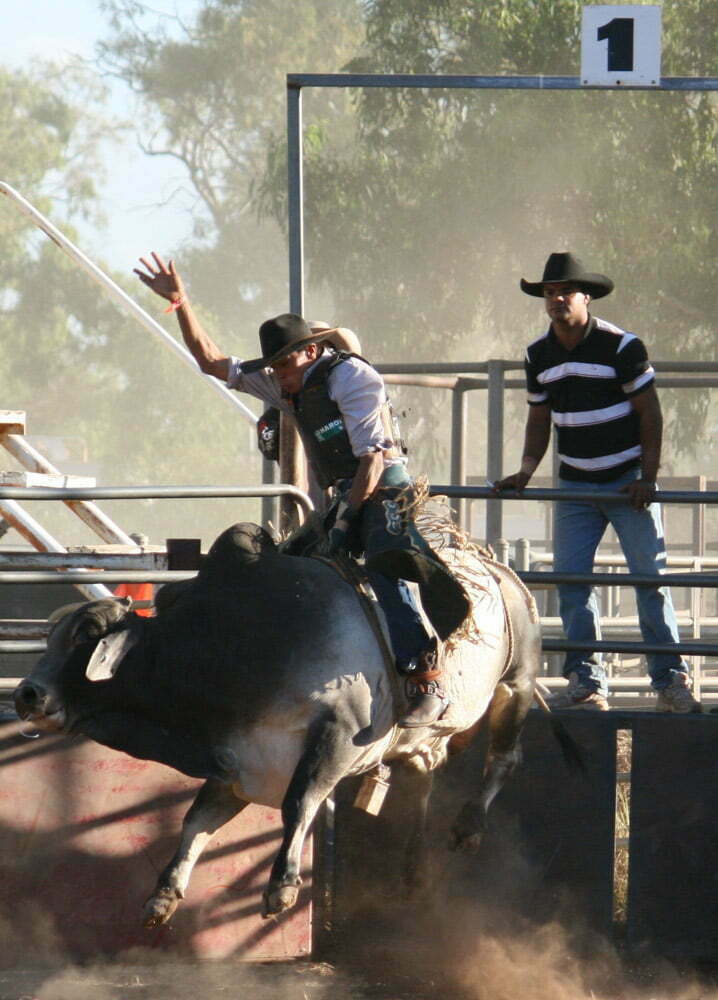Rodeo 101
Questions & Answers
Click title to reveal answers
A very demanding event for the competitor. From the moment the gate swings open and the horse and rider explode from the chute, both must perform exceptionally well if the cowboy is to win. A suit-case like handle is attached to the top of the leather rigging, cinched around the horse’s middle. The contestant grips this handle with one hand, keeps his other free and high in the air. Ideally bareback riders want to try to spur the horse on each jump, reaching as far forward as they can with their feet, then jerking their spurs upwards towards the rigging.
The all female event that tests the speed and agility of both cowgirl and horse. The horses ridden in the event are highly trained and extremely athletic, matching their speed and turns to the cues given by the riders. The clock is set in motion when the girl and the horse cross the starting line and is stopped when she recrosses the line after completing her run. The colourful rider and her mount must make two turns in one direction and one in the other around the three barrels. These barrels are set in a triangular pattern, a prescribed distance apart. Winners are on many occasions determined by differences of hundredths of a second. So the five second penalty for an overturned barrel can be devastating. This event is certainly one of sheer elegance and precise timing.
Another all female event which is the female version of calf roping. This event differs from roping in that the cowgirl does not have to rope the calf, dismount the horse and tie the calf’s legs. Instead, the rope is tied to the saddle horn with a ribbon. When the calf is roped, the horse pulls up and calf keeps running until the rope is taut, which then ‘breaks’ the rope from the saddle horn and the time is taken. This event is contested as hotly by these cowgirls as by the men in the roping.
The most popular rodeo riding event and the most dangerous. A loose rope straps a man’s hand to a tonne of explosive power. Because the cowboy never knows what the animal beneath him is going to do next, he must draw upon his sharpest mental and physical abilities when trying to conquer this twisting tornado. To keep his position and balance, a bull rider is constantly grabbing for new holds with his feet and continually pulling up on the rope. The more powerfully a bull bucks and the faster he spins the more points the ride is worth.
The poddy calf event is for the aspiring bull rider, their very first taste of the rodeo life style. Whilst one might make the mistake of thinking this is more cute than dangerous they would be wrong. Power to weight ratio between the poddy calf and rider is akin to that of their larger counterparts. Much like the older competitors the young rider is strapped to the calf with a loose rope. The poddy calf bucks and twists to buck off the rider. When first starting out the rider often has a support crew helping them stay on, but the fall remains inevitable, the landing just as hard and the desire to jump back on is their before the tears have a chance to form.
An event that shows the grace and beauty of true horsemanship along with the athletic skills of both horse and rider. Roping is a race against time with the seconds counted in decimal points. To win, a horse and rider must work together in precision teamwork. The contest begins when the calf is released from the chute with the rider and horse chasing behind. A good horse will carry its rider in perfect accord with every move of the calf and when the rope is thrown will stoop on a dime, back up so the rope is pulled taut allowing the roper to dismount, run down the rope, throw the calf and tie any three legs with the ‘piggin string’ and then signal ‘all clear’ with his hands in the air. The rider must remount his horse and slacken the rope to prove the tie, which must then hold for six seconds.
Taking the Saddle Bronc event to the next level, the Station Buck Jump is for the highly skilled stockman. Consider the instinctive reactions required to keep in the stirrups, sense what the horse will do next and the ability to synchronise with the bronc’s movement – then add in the requirement to crack a stock whip three times – all without falling off. Timing, balance, skill and sometimes sheer luck keeps the cowboy in the saddle long enough to crack that whip and make time.
Another all-female event which is the female version of steer wrestling. However, in this event rather than having to slide over the side of the galloping horse and stop the steer, the cowgirl has to catch up to the steer and remove the ribbon attached to its back. Like the steer wrestling , the cowgirl is allowed a ‘hazer’ to aid her in lining up the charging steer. This helps her to line up the steer perfectly to allow her to remove the ribbon. Time is taken when she removes the ribbon from the steer and raises it high over her head.
An event that not only requires speed and agility, but also physical size and strength. When a man drops from the side of a galloping horse onto a running steer and throws him to the ground, spectators have seen athletic skill overcome heavily weighted odds. In keeping with the sharing and helping character of rodeo, the steer wrestler is allowed a partner called a ‘hazer’ to aid him in lining up the charging steer. This assistance helps to assure perfect placement of the steer and horse before the cowboy dismounts. The time stops after the contestant has thrown and turned the steer’s head and all four feet are out in the same direction.
An event that owes its very existence to the everyday work of the American working cowboy. On the open range it is often necessary to catch an animal in order to attend to or brand it, and that is where the first team roping took place. In rodeo competition today the header starts the time when he leaves the box in pursuit of the runaway steer. His job is to rope the steer’s horns, take a dally wrapping the loose end of the rope around the saddle horn and turn the steer away from his partner. With great skill and accurate timing the heeler then ropes the steer’s hind legs and takes his dally. Then both header and heeler face their horses towards the steer, time stops. Because of the excellent team work involved this event is a favourite of many.
*Event information courtesy of the ABCRA: www.abcra.com.au

